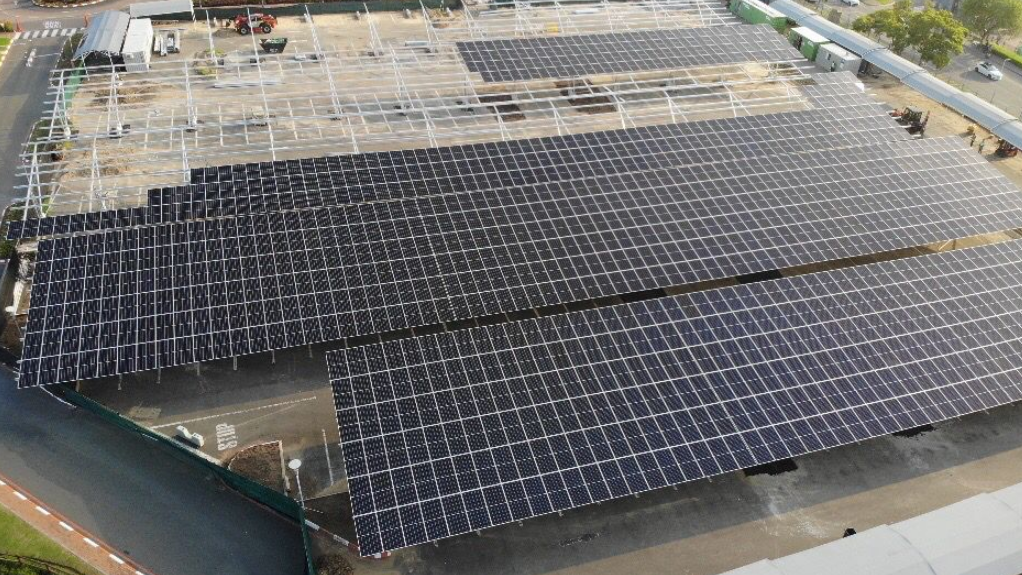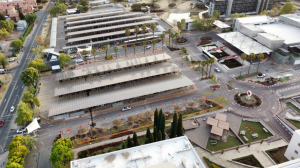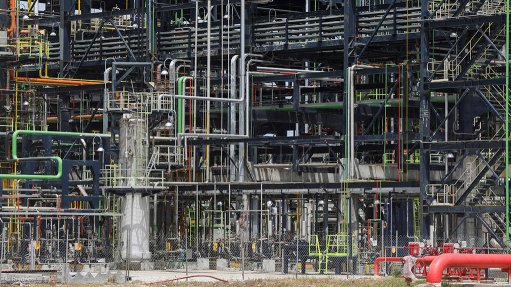Vodacom converts Midrand Campus into group’s largest on-site solar power generation system


Vodacom South Africa managing executive for property and national facilities Shobana Singh discusses the progress of the company’s grid-based solar PV plant at its Midrand campus.
More than 11 000 photovoltaic (PV) panels will be installed at telecommunications service provider Vodacom’s Midrand campus, in Gauteng, by year-end, converting the commercial office park into a grid-based solar PV plant capable of generating 10.5 GWh/y.
The largest on-site solar power generation system in the Vodafone group, the project is progressing ahead of schedule, despite logistical challenges.
“Initial projections were for the plant to be completed in 18 months, owing to the complexities of the installations. However, because of our partners’ ability to manage the project in a fluid manner despite various constraints, including supply shortages, the project will be delivered in 12 months,” says Vodacom group executive for property and facilities Shobana Singh.
The three-phase project, comprising 13 sub-projects, is on track to be completed by December this year. Phase 1 (2.3 MWp), Phase 2 (1.7 MWp) and Phase 3 (2.2 MWp) will supply a combined capacity of 6.2 MWp generated by six rooftop installations and seven newly constructed custom carparks equipped with solar panels. Almost 11 300 solar panels will be installed across 30 000 m2 of rooftops and carports upon completion, tied-in with medium-voltage (MV) and low-voltage (LV) electrical infrastructure used on site.
The Midrand campus has a multitude of services on site, including two data centres, a retail centre and warehouse. Solar PV is expected to supply more than 25% of total capacity during peak generation periods.
MV tied carports will supply almost 70% of the energy generated to the largest energy users on site, this being the data centres, and retail and conferencing facilities, which also includes a gym. Three rooftop installations can also feed any excess energy generated to the data centres.
The first green electrons started flowing through the system in December 2022 to supply Vodacom’s Service Park Office Building and Warehouse.
“The project is currently supplying about 50% operational capacity – 3.1 MWp, producing 14.4 MWh/d and an installed capacity of about 65% will be brought online by end September, giving us a total of 4.1 MWp,” states Singh.
Plant sizing was based on baseload consumption and, using WiFi-enabled real-time monitoring and control, Vodacom can confirm that the yield curves perfectly match the current baseload demand curves, she adds.
“The deep dives, analytics and long hours dedicated to planning and designing the system across the campus have proven to be key to the project’s successful execution phase. This was further enhanced by appointing the correct professional services from concept design through feasibility studies, using a rigorous tender process, involving the technical evaluation of supplier capability and negotiation of the commercial terms to ensure best value.”
Consequently, Vodacom was able to appoint the correct Tier 1 suppliers and source best-in-class products and technologies for implementation.
PPA Development
The project commenced November last year, with the construction of the plant being undertaken in partnership with consulting services company LTM Energy, independent power producer (IPP) Next Renewable Energy and main contractor Green Wave Energy.
The project is the first on-site power purchase agreement (PPA) in the Vodafone group.
“The project is financed through a ten-year PPA with Next Renewable Generation, based on the build, own, operate and transfer principle. At the end of the PPA term, Vodacom will own the solar plant, which has a life expectancy of 25 years,” explains Singh.
The off-balance-sheet PPA has proven to be a successful vehicle through which companies can introduce green energy alternatives to reduce their dependency on the national grid amid South Africa’s energy crisis, as well as decrease their carbon footprint, without committing to a significant capital investment.
Importantly, Vodacom’s PPA also yields a 25% saving against municipal tariffs per kWh, resulting in an operational saving related to cost avoidance.
Singh admits that when first approaching the IPP market for a PPA two years back, involving a smaller on-site installation of this nature, the market was not well developed and securing project financing for a project of this size was a challenge.
“Most of the well-known IPPs were com-peting for large-scale renewable energy IPP projects at the time. Finding an experienced partner that complied with our rigorous governance process, including our health, safety and environmental policies, was also a difficult task.”
Other Challenges
While the original design catered for five sub-1 MW individual installations to comply with South Africa’s embedded generation regulations at the time, during the procurement process in 2021, these regulations changed, increasing the 1 MW licensing threshold to
100 MW. This development prompted Vodacom to adapt its design to maximise energy production and the use of available space. The licensing threshold was removed entirely in July 2022.
Further, cooperation between all role-players was key to managing a fluid project plan to counter the challenges related to supply shortages.
“Six months into the project, 2 MWp was already active and an additional 2 MWp worth of mounting structures and 30% of the MV infrastructure was already completed and awaiting solar panels,” elaborates Singh.
It is worth noting that the installation methods and technology used through this project prompted Vodacom to revisit existing installations and effect changes to improve efficiencies and add monitoring capabilities, states Singh, adding that Vodacom is busy with an optimisation and modernisation project for all its existing plants.
“Managing our own expectations and that of senior management from the date that the project was awarded to it being shovel ready was another challenge. It was a daunting task, from the drafting of the PPA contract to satisfying the multitude of conditions precedent.”
Corporate Purpose
Singh highlights that the project forms a key component of Vodacom’s planet pillar strategy through which the company aims to grow and foster a green culture in its organisation and the communities it serves.
“The greening of our energy supply forms part of the larger framework in which we account for energy efficiency practices, sourcing our energy needs from clean alterna-tives and green procurement.”
Before introducing solar power generation capacity at Vodacom’s Midrand campus, energy efficiency was the initial goal, emphasises Singh.
“For the commercial and warehouse environ-ments our energy efficiency efforts have realised a 54% reduction in energy consumption in the last eight years. Cost savings and cost avoidance, energy security and reducing our carbon footprint are key successes, but one of the most valuable outcomes has been the education of and behavioural changes in our staff.”
Vodacom expects to effectively reduce its greenhouse-gas emissions by almost 11 000 t/y, owing to its Midrand solar PV installation.
Moving Forward
The grid-connected embedded generation project automatically turns off during loadshedding and power failures. However, Vodacom is working with its partners on solutions to lessen dependence of the Midrand campus on diesel generators in such instances.
“We are also investigating an optimal renewable technology mix to supply the campus with the remaining energy requirement and provide energy security,” adds Singh.
Apart from virtual wheeling platforms and off-site PPAs, the company intends to expand its efforts, where feasible, to Vodacom-owned buildings, which include offices and data centres.
“We are also consulting the owners of our leased properties to push for green solutions as we renew or enter new agreements. Our major distribution centre and disaster recovery sites are current examples of new renewable energy installations,” says Singh.
Vodacom’s Lesotho headquarters currently obtains 60% of its power from solar energy, while its Century City office, in Cape Town, obtains just more than 30%.
Singh says it is hoped that the Cape Town office’s solar installations will be back online after Vodacom repairs and restores the building following fire damage, which was caused by an electrical fault from within the building and not its solar rooftop installation.
Article Enquiry
Email Article
Save Article
Feedback
To advertise email advertising@creamermedia.co.za or click here
Comments
Press Office
Announcements
What's On
Subscribe to improve your user experience...
Option 1 (equivalent of R125 a month):
Receive a weekly copy of Creamer Media's Engineering News & Mining Weekly magazine
(print copy for those in South Africa and e-magazine for those outside of South Africa)
Receive daily email newsletters
Access to full search results
Access archive of magazine back copies
Access to Projects in Progress
Access to ONE Research Report of your choice in PDF format
Option 2 (equivalent of R375 a month):
All benefits from Option 1
PLUS
Access to Creamer Media's Research Channel Africa for ALL Research Reports, in PDF format, on various industrial and mining sectors
including Electricity; Water; Energy Transition; Hydrogen; Roads, Rail and Ports; Coal; Gold; Platinum; Battery Metals; etc.
Already a subscriber?
Forgotten your password?
Receive weekly copy of Creamer Media's Engineering News & Mining Weekly magazine (print copy for those in South Africa and e-magazine for those outside of South Africa)
➕
Recieve daily email newsletters
➕
Access to full search results
➕
Access archive of magazine back copies
➕
Access to Projects in Progress
➕
Access to ONE Research Report of your choice in PDF format
RESEARCH CHANNEL AFRICA
R4500 (equivalent of R375 a month)
SUBSCRIBEAll benefits from Option 1
➕
Access to Creamer Media's Research Channel Africa for ALL Research Reports on various industrial and mining sectors, in PDF format, including on:
Electricity
➕
Water
➕
Energy Transition
➕
Hydrogen
➕
Roads, Rail and Ports
➕
Coal
➕
Gold
➕
Platinum
➕
Battery Metals
➕
etc.
Receive all benefits from Option 1 or Option 2 delivered to numerous people at your company
➕
Multiple User names and Passwords for simultaneous log-ins
➕
Intranet integration access to all in your organisation


















